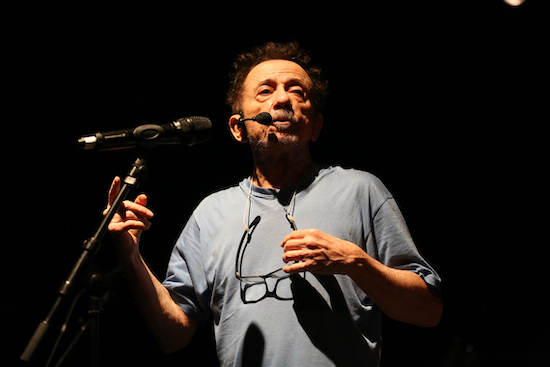Oct 28, 2025 10:47 AM
In Memoriam: Jack DeJohnette, 1942–2025
Jack DeJohnette, a bold and resourceful drummer and NEA Jazz Master who forged a unique vocabulary on the kit over his…

Tom Zé was part of a Brazilian contingent at the Moers Festival—which ran June 7-10 in Moers, Germany—that also included Clube Da Encruza, Sambanzo and Absimu Curtu.
(Photo: Hans Walter Kropp)The Moers Festival started in 1971, and its roots reach deep into the vortex of free improvisation. That’s still the case today, even as ample room’s been made for rock, electronics and folkloric grit.
The festival—which ran June 7-10 in Moers, Germany, just north of Düsseldorf—revels in unpredictability, both in sound and environment. Tim Isfort, now in his third year as artistic director, has continued the event’s established vibrations, while increasing the aura of controlled chaos and spontaneous vitality.
This year, the main stage at Festival Hall was rebuilt in a diagonal fashion, occupying a corner, with the venue’s seating rearranged. A huge wooden tank dominated the back of the stage, garden gnomes gathered outside the main hall and helium balloons featured artist’s names on their surfaces. A sprawl of food and drink vendors was just outside the main hall, as well as a secondary stage alternating its set times with indoor programing.
There’s a consistent glut of inspiring performances, and this year, the festival offered a particularly strong international character, inviting substantial performers from Tokyo and São Paulo, as well as hosting several acts from France and Serbia.
The 82-year-old Tom Zé retains a childlike curiosity—and the body language of a much younger man—his status as Brazil’s most idiosyncratic songwriter undiminished. Zé embodied the spirit of the festival, his words coming in doses both amusing and profound. Other Brazilian players appeared in multiple permutations, different bands with contrasting musical aims. The main-stage set by Clube Da Encruza was mellow—bordering on bland—but the quartet offshoot of Sambanzo played one of the weekend’s highlight sets, loaded with seething saxophone solos and nagging basslines. Another Brazilian sub-combo, Absimu Curtu, ventured into minimalist ambient areas, experimentally abstract.
The Tokyo outfits stretched from the avant-smooth irritations of Yasei Collective to the more imaginative contributions of Tatsuya Yoshida (drums) and Toshimaru Nakamura (electronics). Generally, the French contingent made less of an impact, aside from Abacaxi, the trio fronted by guitarist Julien Desprez, specializing in a stuttering punk-funk complexity, loaded with extreme textures and operating a tap-dancing approach to effects pedals.
From Belgrade, the D.K. Heroes delivered a quality main-stage set, but were best experienced late each night in the Vortex Kafana, a small tent outside the main hall that aimed to recreate a Serbian tavern experience. Smoking and shots of Slivovic were encouraged, while largely toothless fiddler Zelko Stefanović and guitarist Vania Stojnov—who fronted a quintet—vied for flyaway complexity in their exuberant solos.
The weekend’s kaleidoscope also featured a meeting between the Arkestra’s Marshall Allen (saxophone/electronics) and Günter “Baby” Sommer (drums); saxophonist Joshua Redman fronting the WDR Big Band (playing “Moers Abstractions,” a descendant of Gunther Schuller’s “Jazz Abstractions”); and a sequence of artists appearing from the spotlit tiered seats of the main hall, including a rare showing by English vocalist Phil Minton and the Tokyo duo Akaten, soloing on hugely amplified fly-zippers.
Assembling members of Faust, Fire! and dälek, Anguish made its debut live appearance, providing a fitting festival peak. As its set progressed, the ensemble gathered a sludge-slow headbanging mass of rap, industrial electronics layering and ripping tenor saxophone soloing, the latter courtesy of a typically enraged Mats Gustafsson.
This year, the Moers Festival aggressively pursued a crusading internationalism, aiming to counteract current global strife, even if it’s all just a weekend immersion in an alternative existence. The Global Improvisers Orchestra made its debut, as well, combining players from nine countries. It was led by saxophonist Jan Klare, who also organized the improvising Moers Sessions, which took place early each morning and then again late each night.
Rarely can such vivid cross-fertilization be witnessed during a single festival, as artists who hadn’t previously played—or even met—produced vibrant results in mixed, small groups. DB

Jack DeJohnette boasted a musical resume that was as long as it was fearsome.
Oct 28, 2025 10:47 AM
Jack DeJohnette, a bold and resourceful drummer and NEA Jazz Master who forged a unique vocabulary on the kit over his…

D’Angelo achieved commercial and critical success experimenting with a fusion of jazz, funk, soul, R&B and hip-hop.
Oct 14, 2025 1:47 PM
D’Angelo, a Grammy-winning R&B and neo-soul singer, guitarist and pianist who exerted a profound influence on 21st…

Kandace Springs channeled Shirley Horn’s deliberate phrasing and sublime self-accompaniment during her set at this year’s Pittsburgh International Jazz Festival.
Sep 30, 2025 12:28 PM
Janis Burley, the Pittsburgh International Jazz Festival’s founder and artistic director, did not, as might be…

Jim McNeely’s singular body of work had a profound and lasting influence on many of today’s top jazz composers in the U.S. and in Europe.
Oct 7, 2025 3:40 PM
Pianist Jim McNeely, one of the most distinguished large ensemble jazz composers of his generation, died Sept. 26 at…

Drummond was cherished by generations of mainstream jazz listeners and bandleaders for his authoritative tonal presence, a defining quality of his style most apparent when he played his instrument unamplified.
Nov 4, 2025 11:39 AM
Ray Drummond, a first-call bassist who appeared on hundreds of albums as a sideman for some of the top names in jazz…